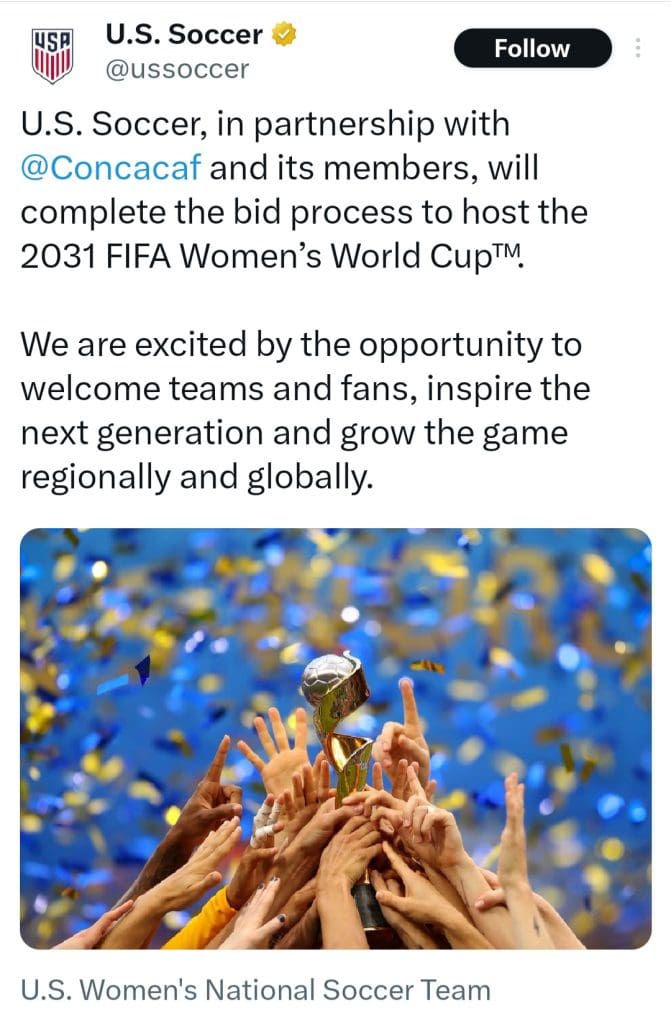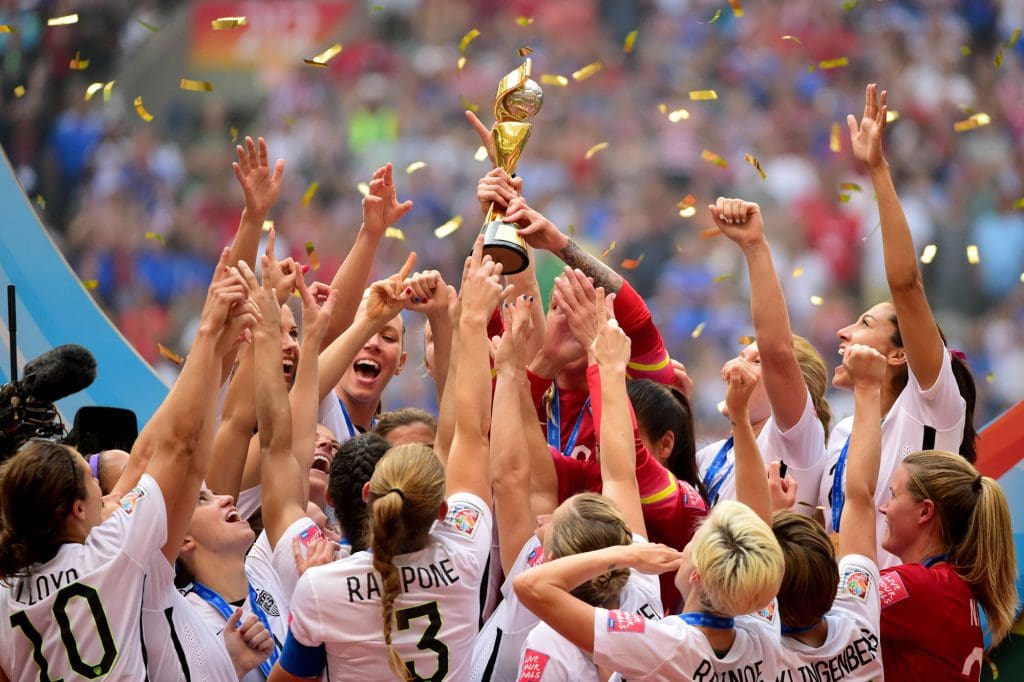The United States is in the middle of a stretch where it seems like all things soccer are being played on these shores. The 2023 Gold Cup was played here, as it usually is. In 2024, Copa America was played in the US for the second time in eight years. This year, the US will play host to both the Club World Cup and the Gold Cup, with the bulk of the Club World Cup games set to be played East of the Mississippi River and all of the Gold Cup game set to be played West of the Mississippi River. Next year, of course, the World Cup is coming to the United States (as well as Mexico and Canada). And in 2028, Los Angeles hosts the Summer Olympics which will include both men’s and women’s soccer.
Unfortunately, despite initially announcing a bid, US Soccer ultimately decided not to host the 2027 Women’s World Cup, which will now be played in Brazil. However, they announced on Wednesday that they will now be submitting a bid to host the 2031 Women’s World Cup. With that in mind, which stadiums should be used as the Women’s World Cup venues in 2031?

The stadiums that the US uses should be spread out across the country and include a mix of stadiums that were used in hosting the 2026 World Cup as well as stadiums that were not part of the World Cup. Because the 1999 Women’s World Cup, and to a lesser extent the 2003 Women’s World Cup, famously showed that large NFL stadiums in the US could be filled up, most of the prospective venues should be ones with large capacities. But there should also be a few smaller, soccer-specific stadiums as well. This would not be without recent precedent. Of the ten stadiums used at the 2023 Women’s World Cup in Australia/New Zealand, five of them were under 30,000 (and three of those five were under 20,000) while six of the nine venues at the 2019 Women’s World Cup in France were under 30,000 (with two of the six under 20,000).
Here is a look at the best options for US venues at the 2031 Women’s World Cup.
Camping World Stadium (Orlando, FL)
Capacity: 60,219
For events of this magnitude, it would be foolish not to have games in Florida. Orlando was not chosen as a host city for the 2026 World Cup (though they did host games at the 1994 World Cup and the 1996 Olympics) so getting Women’s World Cup games in 2031 would be met with enthusiasm. Additionally, Orlando is home to the Orlando Pride in the NWSL. They play at the soccer-specific Inter&Co Stadium where they have averaged 6,250 fans per game over the last two seasons.
Audi Field (Washington DC)
Capacity: 20,000
Yes, it is a small soccer-specific stadium. But Washington DC was not chosen to host any games at the 2026 World Cup due to the disaster that is Northwest Stadium, home of the NFL’s Commanders. Quite frankly, it would be a travesty for the nation’s capital to not host any games at either the World Cup or the Women’s World Cup. Audi Field is home to DC United of MLS as well as NWSL’s Washington Spirit (who have averaged 11,034 fans per game at Audi Field since 2022). Nor is Audi Field unfamiliar with hosting big time soccer events. The USWNT played there last summer before heading to the Olympics. They hosted the 2023 MLS All-Star Game and will be hosting games at this year’s Club World Cup.
Geodis Park (Nashville, TN)
Capacity: 30,109
Geodis Park is new, having opened in 2022, and is the largest soccer-specific stadium in the country. Nashville has also proven to be a great soccer town over the last seven or eight years, with numerous USMNT and USWNT appearances, plus plenty of support for Nashville SC. And while they were unfortunately one of the last cities to miss the cut for 2026 World Cup hosting duties, they do get to host three games at this summer’s Club World Cup. Nashville is also a city that is easy to get to from a number of other cities, with numerous interstates running through the city.
Soldier Field (Chicago, IL)
Capacity: 61,500
Chicago seems to be the one city in the US that is not directly benefitting from all the soccer being played here. They did not get any Copa America games in 2024, they are not getting any Club World Cup games in 2025, and they will not be getting any World Cup games in 2026. So it should be obvious that they deserve Women’s World Cup games in 2031. Chicago is a massive market and Soldier Field has hosted numerous soccer games over the years, including the 1994 World Cup and the 1999 Women’s World Cup.
Lincoln Financial Field (Philadelphia, PA)
Capacity: 67,594
Philly has proven itself to be a town quite capable of hosting high-level international soccer events. It is one of the eleven US venues for the World Cup in 2026, as well as one of the twelve venues for the Club World Cup this year. CONCACAF Gold Cup games have been held there four times: 2009, 2015, 2017, and 2019. It also played host to games at the Copa America Centenario in 2016. And most appropriate for this discussion, was one of the host venues at the 2003 Women’s World Cup.
MetLife Stadium (East Rutherford, NJ)
Capacity: 82,500
A “no-brainer.” It is New York (yes even though the stadium is over in New Jersey). New York City is the number one media market in the US and will be hosting games at the 2025 Club World Cup and the 2026 World Cup as they did at the 1994 World Cup, the 1999 Women’s World Cup, the 2016 Copa America Centenario, and the 2024 Copa America. While neither of the two MLS teams nor the NWSL team is particularly well-attended, New York is a lock to get games.
AT&T Stadium (Arlington, TX)
Capacity: 80,000
The DFW area, and “Jerry World” in particular, is no stranger to hosting huge events, be it soccer or other sports. But in terms of soccer, AT&T Stadium has been a favorite of the Mexican national team for years (El Tri has played here 16 times and averaged 64,124 per game). The stadium also hosted three games at the 2024 Copa America and will host nine games at the 2026 World Cup, more than any other venue. It was also just announced that the DFW area, like they did for the 1994 World Cup, will host the International Broadcast Center. But since there is no professional women’s team currently in Dallas, perhaps games at the 2031 Women’s World Cup could generate enough interest to make one happen.
State Farm Stadium (Glendale, AZ)
Capacity: 72,200
Being an NFL venue with a grass field helps the Phoenix suburb’s case for being a Women’s World Cup host venue in 2031. The United States passed on State Farm Stadium as a World Cup 2026 host and, for some reason, wasn’t even part of the bid. However, the home of the Arizona Cardinals has hosted the Gold Cup six times. In 2016, the stadium hosted three games for the Copa America Centenario and then hosted three more Copa America games in 2024. Additionally, the USMNT has played there six times with an average attendance of 39,624 while the USWNT has played there four times with an average attendance of 18,155.
Rose Bowl (Pasadena, CA)
Capacity: 92,542
If the Rose Bowl weren’t already iconic as a college football venue, it would be iconic as an international soccer venue. It hosted games at the 1984 Summer Olympics (including the gold medal game which drew 101,799), the 1994 World Cup (including the final which drew 94,194), the 1999 Women’s World Cup (including the final which drew 90,185), and the 2016 Copa America Centenario. It’s also slated to host six games at this summer’s Club World Cup as well as a number of games at the 2028 Summer Olympics. The debate, however, is if the Rose Bowl should be used at all or if the newer and shinier SoFi Stadium should be used instead (as it was for the 2024 Copa America and as it will be for the 2026 World Cup). But the Rose Bowl saw one of the most iconic moments in women’s soccer history when Brandi Chastain famously took her shirt off after scoring the penalty that gave the US their second title. And that should be the deciding factor.
Levi’s Stadium (Santa Clara, CA)
Capacity: 68,500
The Bay Area has a huge soccer following. The USWNT has played at the 18,000-seat PayPal Park in San Jose five times and averaged 16,945. Levi’s Stadium was also the site of four games at the 2016 Copa America Centenario as well as two games at the 2024 Copa America. Additionally, Levi’s Stadium will be one of the eleven US venues at the World Cup in 2026. It too has a grass field which means less work for ground crews to prepare for hosting Women’s World Cup games. The Bay Area has also previously hosted Women’s World Cup games at nearby Stanford Stadium back in 1999.
Providence Park (Portland, OR)
Capacity: 25,218
Providence Park is another smaller, soccer-specific stadium but it is a special place. Portland is one of the best soccer cities in America (despite the USMNT having not played there since 2013 and the USWNT having not played there since 2012). Both the Timbers in MLS and the Thorns in the NWSL pack the place out for nearly every home game. But arguably the biggest reason Providence Park should be one of the US venues at the 2031 Women’s World Cup is that it would be the first stadium in history to host games at three different Women’s World Cup tournaments, hosting four games in 1999 and six games in 2003. Much like the Rose Bowl should get the nod over SoFi Stadium because of the women’s soccer history, so too should Providence Park get to host games in 2031 because of the women’s soccer history.
Lumen Field (Seattle, WA)
Capacity: 68,740
Much like Portland, Seattle is a great soccer town despite appearances from the USMNT and USWNT being few and far between. The Sounders in MLS were for years the gold standard of American soccer support, thought they have fallen off slightly in recent years. Their NWSL side, Seattle Reign, plays at Lumen Field as well and has averaged 8,696 fans per game the last three seasons. Seattle is also no stranger to hosting high-level international tournaments as they were one of the venues for the 2016 Copa America Centenario and will be one of the venues for both the 2025 Club World Cup and the 2026 World Cup.
====================================================================
With so much high-level soccer being played in the US, the sky is the limit for the growth of the game. The Gold Cup in 2023, Copa America in 2024, the Club World Cup and the Gold Cup this year, the World Cup next year, the Olympics in 2028, and now hopefully a Women’s World Cup in 2031 can all combine to really push the game of soccer in the US to the next level. If soccer can’t “make it” now, will it ever?
Photo Credit: The Atlantic

